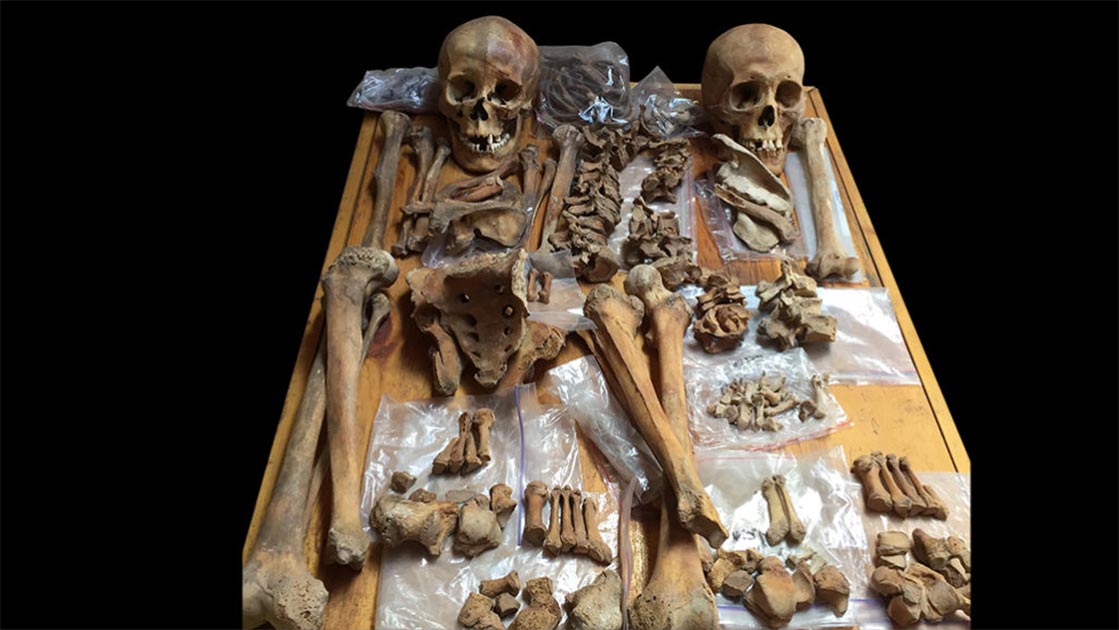Are Skeletal Wounds On Hunter-Gatherer Women Battle Scars Or Execution Marks?
Historic gender archetypes of hunter-gatherer women are being challenged by a team of researchers whose new study presents further evidence of “warrior women” in prehistory.
Traditional archaeological views generally hold females being mostly responsible for gathering foods and raising young, but this is “much too simplistic,” according to forensic anthropologist Dr. Marin Pilloud of the University of Nevada, Reno. Two research teams had planned to present their new findings on April 17 at the annual meeting of the American Association of Physical Anthropologists, which has now been canceled due to the coronavirus pandemic, but Science News has now published a research article about the new study.
In this new two-part paper, the analysis of skeletal remains of hunter-gatherers excavated in what is today California, and from herders in ancient Mongolia, presents evidence of ancient warring women. The paper claims around 5,000 years ago, hunter-gatherer cultures in central California and later Native Americans groups who occupied the same region, such as Coast Miwok and Yana, trained woman as warriors.
This suggests sexual divisions of labor in ancient societies were “not as rigidly enforced” as is generally assumed, and that the historic stereotype of men as hunters, fishers and fighters, while women gathered and prepared plant foods, and undertook child care, might need reconsidered.
Mounted Warrior Women, or Victims of Surprise Attacks?
During the study Dr. Pilloud and her colleagues analyzed 128 female hunter-gatherer skeletons from 19 Native American groups in central California dating to between 5,000 and 200 years ago. The women’s skeletons had a wide array of damage from arrow penetration wounds to slash marks caused by heavy sharp objects, and these wounds were then compared to the injuries noted on 289 male warriors. The scientists say it is unclear whether the 128 women fought alongside men or carried out other dangerous battle duties, for example, “sneaking up on enemies to cut their bow strings.”

Depiction of Native American warrior woman. (Roger / Adobe stock)
This raises an important question: were the hunter-gatherer women riding around on war horses firing arrows at enemy warriors, or were they “sneaking” around clipping enemy bow strings: the answer making quite a big difference to the claims being made of “trained warrior women,” considering a six-year-old might be employed to sneak.
According to biological anthropologist, Patricia Lambert, of Utah State University in Logan, in Native American ancient Californian tribal warfare, women were often executed “in surprise raids and other attacks,” which perhaps partly explains the range of female injuries reported in the new study, meaning we must perhaps be cautious when interpreting the term “warrior women.”
New Findings Support Skeletal Database Stats
Study coauthor, Al Schwitalla, of Millennia Archaeological Consulting, compiled evidence from a skeletal database of “18,000 central California hunter-gatherers” and a 2014 study published in Science News informed: “10.7 percent of males in the database had been injured with sharp blades and projectile points, versus 4.5 percent of the female skeletons.” Dr. Pilloud said her new study affirms this male female split as her researchers found a similar percentage of injuries on the skeletons of men and women.
Patricia Lambert said the paper's analysis of the Californian skeletons suggests “some women” may have fought in battles, either to defend their children or village or as warriors, but she insists further evidence of female fighters, “such as Native American women in California buried with weapons and other battle artifacts, is needed,” before history needs rewriting.
The Mongolian Women Trained As Warriors
The paper presents a second skeletal analysis of nomadic herders in ancient Mongolia bordering northern China, which I wrote about last week in an Ancient Origins news piece. Anthropologist Dr. Christine Lee and her colleague Yahaira Gonzalez, from California State University in Los Angeles, had planned to deliver a speech at the 2020 American Association of Physical Anthropologists conference titled, “T he Hidden Lives of Women,” presenting new archaeological research about warrior women during the Xianbei period, from 147 AD to 552 AD.
- What Makes Spartan Women So Different From Other Ancients?
- Amazon Warrior Discovered in Ancient Armenian Grave
- Was This Wounded Female Viking Really A Warrior?

Representation of an ancient Mongolian/Chinese warrior woman. (mcarutemu / Adobe stock)
Lee and Gonzalez studied nine individuals buried in a high-status Mongolian tomb from the Xianbei period, and two of the women displayed signs of having been trained to ride horses in armed combat, but their research determined the two women had never actually fought in any battles, suggesting they were elite females of the noble classes who were forbidden to fight in wars.
Top image: Researchers are challenging historic gender archetypes, revealing many “battle scars” on skeletal remains pointing to the existence of warrior women. Pictured: skeletons of two people buried in an ancient tomb in Mongolia include a woman (left) who may have been a horse-riding, bow-and-arrow-wielding warrior, scientists say. Source: Christine Lee / California State University
By Ashley Cowie




















Comments
Stopped after reading about horses in North America 5000 years ago.
There weren't horses in North America 5000 years ago.
Also, any group/tribe/nation that uses women in combat are foolish. If all or a majority of your women die in combat and you have no women, your group/nation/tribe has no future.